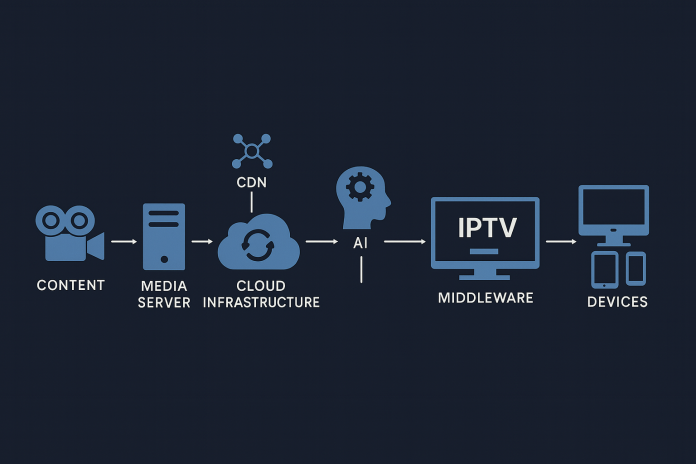Television is evolving from traditional broadcasting to something more intelligent, adaptive, and connected. At the center of this shift is IPTV, or Internet Protocol Television a technology that delivers live and on-demand content over the internet instead of through satellite or cable. In the Netherlands, where broadband penetration exceeds 97 percent, IPTV has become more than just a streaming option; it represents a complete transformation in how digital entertainment is engineered and experienced.
Unlike conventional television, IPTV is powered by advanced software ecosystems that control everything from content delivery to personalization. It relies on robust backend servers, cloud-native infrastructure, and adaptive streaming protocols that adjust quality in real time based on the user’s bandwidth. This isn’t merely television over the internet; it’s a finely tuned software operation that merges networking, analytics, and automation.
The Software Behind IPTV: Streaming Reimagined
At its core, IPTV operates on a software-defined architecture. Content is encoded, segmented, and transmitted using protocols like HTTP Live Streaming (HLS) and MPEG-DASH, which allow for dynamic bitrate adjustments. These technologies ensure smooth playback on multiple devices whether that’s a 4K television in Amsterdam or a smartphone in Rotterdam.
Once data leaves the media servers, content delivery networks (CDNs) distribute the streams globally. Each CDN node stores cached video segments closer to end users, minimizing latency and buffering. Platforms also employ middleware systems that act as the control center, managing user authentication, billing, channel subscriptions, and analytics.
This middleware, often built on scalable cloud platforms like AWS and Google Cloud, integrates APIs for real-time monitoring and data synchronization. It’s this layer that allows users to pause live broadcasts, rewind, or watch from different devices using the same profile. In essence, IPTV isn’t just about streaming; it’s about intelligent data management powered by modern software stacks.
AI and Personalization in IPTV Platforms
The next phase of IPTV’s growth in the Netherlands is driven by AI and machine learning. Platforms are increasingly using recommendation engines that analyze user behavior to suggest personalized content. According to Statista, IPTV now accounts for nearly one-third of all household internet traffic in Western Europe, illustrating how deeply integrated it has become in modern digital infrastructure.
This data-driven approach relies on predictive analytics, content clustering, and natural language processing. AI models analyze what users are watching, when they watch it, and on which devices. These insights feed back into the middleware systems to optimize not only recommendations but also ad targeting and server load distribution.
AI also powers real-time quality optimization. Algorithms monitor video packet loss, detect playback interruptions, and dynamically reroute streams to maintain stability. This automation means that every viewing experience can be adjusted instantaneously, something traditional broadcasting could never achieve.
Security, DRM, and Data Protection
Streaming may be convenient, but it comes with new challenges. IPTV providers must ensure the secure transmission of copyrighted material while protecting user data. To achieve this, they use Digital Rights Management (DRM) frameworks such as Widevine and PlayReady. These encrypt content during transmission and restrict unauthorized access based on user licenses.
In the Netherlands, where GDPR compliance is mandatory, IPTV services also invest in data anonymization and multi-factor authentication protocols. Subscriber databases and usage logs are often stored in distributed ledger systems or zero-trust cloud environments to prevent leaks or manipulation. The software-driven security infrastructure is as critical as the content itself — it ensures that streaming remains both legal and trustworthy.
Integration with Smart Devices and Cloud Infrastructure
Modern IPTV systems are designed with integration in mind. Smart TVs, voice assistants, and even Internet of Things (IoT) devices now form part of the user ecosystem. Through APIs and cloud-based orchestration platforms, IPTV services can deliver synchronized content across all devices in a household.
For example, a user could start watching a film on a Samsung smart TV, continue on a tablet during their commute, and finish it on a laptop without losing their playback position. This seamless experience is achieved through session continuity software, which stores real-time viewing data in the cloud and synchronizes it via microservices.
Telecom providers in the Netherlands are also leveraging 5G and edge computing to enhance IPTV performance. By processing data closer to the user, edge nodes reduce latency and bandwidth strain. This innovation allows ultra-high-definition (UHD) content to stream smoothly even during peak traffic hours, improving both user satisfaction and network efficiency. A 2024 study by Statista found that IPTV traffic now accounts for nearly one-third of all household internet usage in Western Europe, underscoring how deeply integrated these systems have become.
The Dutch Market: A Software-Led Success Story
The Netherlands is a leader in digital infrastructure, and that has helped IPTV flourish. Dutch ISPs such as KPN and Ziggo have already upgraded much of their backend infrastructure to support IP-based delivery networks. They deploy hybrid fiber-cloud systems that combine fiber-optic speed with cloud scalability.
Moreover, government-backed digital initiatives are fostering open API ecosystems that allow third-party developers to build interactive layers on top of IPTV systems. These can include real-time polling during live events, on-screen data visualization for sports, and dynamic advertising modules that change based on audience demographics.
Such modularity is what sets IPTV apart; it’s not a fixed broadcast stream but a programmable media environment that can evolve continuously through software updates and integrations.
Challenges and Future Innovations
Despite rapid growth, IPTV still faces challenges. Bandwidth congestion, rising infrastructure costs, and the need for global content licensing remain key issues. To address these, developers are experimenting with peer-assisted streaming and blockchain-based rights management, which decentralize traffic and ensure transparent royalty tracking for creators.
Future IPTV systems are expected to incorporate AI-driven content compression, allowing more data to be transmitted with less bandwidth, and autonomous self-healing networks, where software can predict failures and reroute traffic before viewers notice. These innovations will make IPTV more resilient, sustainable, and adaptive to critical factors, such as the standardization of 4K and 8K streaming.
Conclusion: Television Becomes Software
The rise of IPTV in the Netherlands represents more than just a change in how people watch television. It’s the story of how software engineering, data science, and cloud infrastructure have converged to redefine entertainment.
Every stream, every click, and every recommendation is the result of complex backend orchestration that merges AI analytics with real-time delivery systems. As broadband expands and AI matures, the line between broadcasting and computing will continue to blur.
Television is no longer a passive medium. It’s a living, evolving software service and the Netherlands is showing the world what that future looks like.











